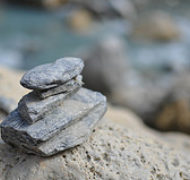Cairn-making
Blog / Produced by The High Calling
Occasionally, I let college students get lost in the woods. One time it even happened in the middle of the night. The group had been instructed to reach a certain point on the map in order to set up camp, but outspoken members were ignoring advice from quiet members. Since the aim of the weekend was to improve communication, I let all of them get lost.
Okay, so I knew the area. And I had set parameters. I had taught them to use a map and compass, for example, though they were presently disregarding both. But I also recognized the importance of a lesson to be learned in this particular way by a team that was failing at the goal of the trip.
What they needed was something called a cairn. A cairn is a pile of rocks along the trail. Cairns usually show up where signs are absent; where it’s difficult to discern how to proceed. Cairns aren’t big, necessarily, and they don’t always explain what you are supposed to do, but they offer a simple reminder: “You’re on the right path.”
College students have big questions. Who am I? Why am I here? What company should I keep? Where am I going? These are direction questions—cairn questions—whose answers affect every area of the future. I care deeply about how these get answered.
But two challenges seem to make it difficult. First, many students have been encouraged to choose whatever path they wish. Parents ought to let go, as you know, but too often they endorse uninhibited exploration. Second, with the world flattening by social media, young adults feel so much pressure to accommodate a growing diversity of friends that they end up wearing the badge of acceptance. Instead of being human cairns, peers disassemble themselves and meld with the surrounding environment.
They become scattered stones that look like all the rest.
In the lost group, one young woman at the back mumbled, “Didn’t we just come this way?” Nobody heard her, and I asked, “What was that?” She replied, “The ravine we need seems to go that way, but I think we’re going in circles.” I said nothing to the group. That was her job. We continued in circles and I finally asked, “What makes you question what your peers are doing?” Her reply clearly indicated that she was right, but she just followed on, aware of some greater truth but doubtful that her voice should be heard. She was the disassembled cairn.
Maybe it was timidity that kept her quiet. Still, I had to say: “If you know the truth and see that your team members could end up in trouble, why wouldn’t you stop them? You’ve got to stop them.”
Add this kind of deference to a high regard for pluralism and then to an atmosphere where the Church has made enough mistakes that its congregants downplay their allegiance, and it makes me wonder how the next generation will proceed.
“This is what the LORD says: ‘Stand at the crossroads and look; ask for the ancient paths, ask where the good way is, and walk in it, and you will find rest for your souls’” (Jeremiah 6:16).
What an opportunity we have! You and I can take up the high calling of cairn living. Maybe you have already. You have a college intern who relies on you for wisdom. You have a nephew heading off to school this fall who considers you a confidant. You are his cairn.
Years of service, cultural insight, your walk with God, lessons learned from getting lost here and there along the way—these combine to make you the consummate trip guide. And what a high calling it is!
It was after midnight before the group at last admitted failure. They gathered in a jumbled circle, a third of them still hashing out solutions that supposedly remained. The girl stayed quiet. I shook my head in the dark, and asked if everyone’s opinions had been requested. Yes, they said. She stayed quiet. I asked the decision-makers to ask again, this time having them call on each member of the group.
That’s when she spoke up.
Image by Sylvain Naudin. Used with permission. Sourced via Flickr. Post written by Sam Van Eman.





